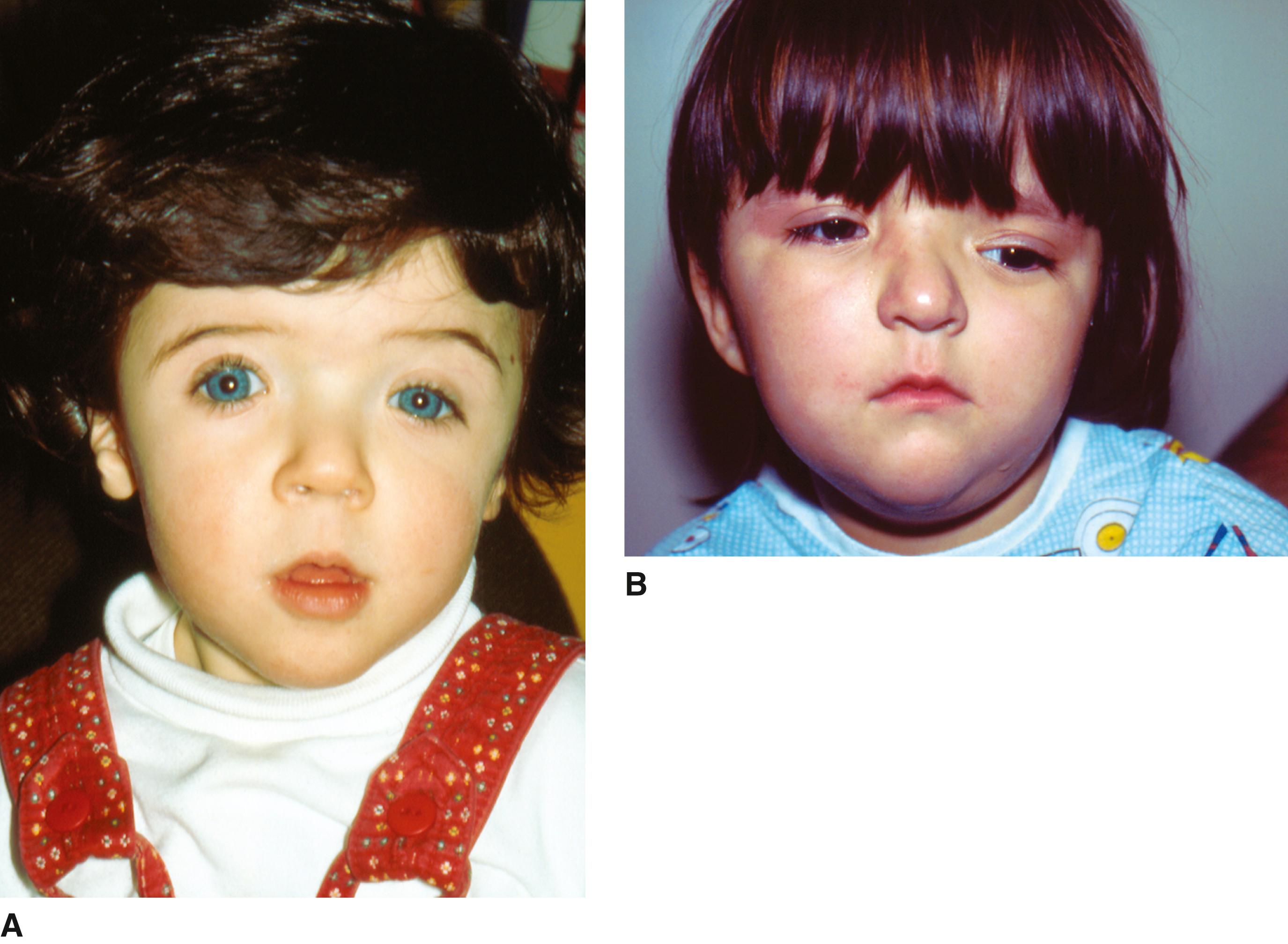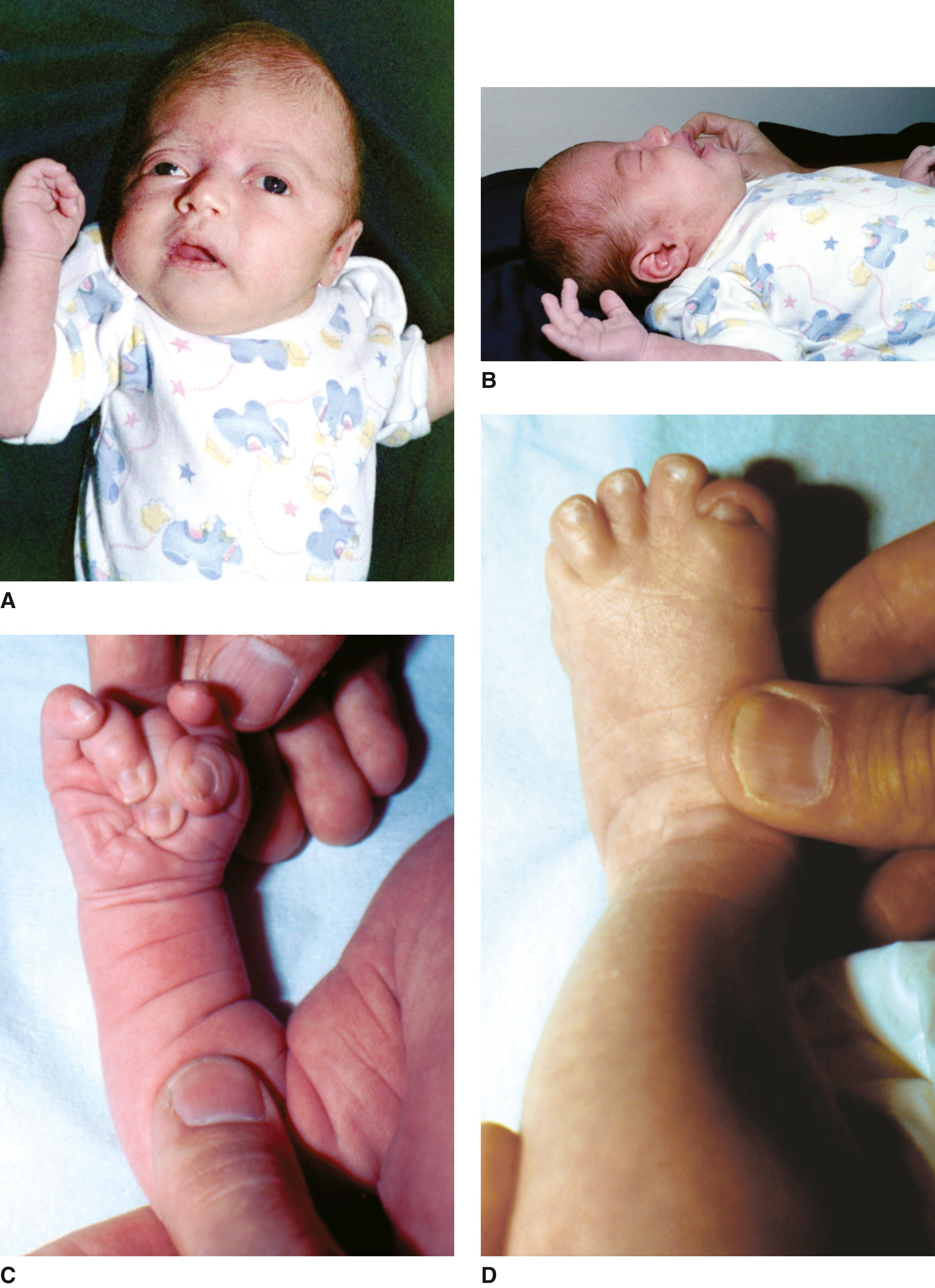Physical Address
304 North Cardinal St.
Dorchester Center, MA 02124
Originally described by Saethre and by Chotzen in the early 1930s, this disorder has an estimated prevalence of 1 in 25,000 to 1 in 50,000 live births.
Craniofacial. Craniosynostosis, most commonly coronal, but also sagittal, lambdoidal, metopic, or multiple sutures; late closing fontanels; brachycephaly with high flat forehead; low frontal hairline; shallow orbits; hypertelorism; downslanting palpebral fissures; ptosis of eyelids; lacrimal duct abnormalities; maxillary hypoplasia with narrow palate; facial asymmetry with deviation of nasal septum.
Eyes. Strabismus.
Ears. Prominent ear crus extending from the root of the helix across the concha; small, posteriorly rotated ears.
Limbs. Cutaneous syndactyly, usually partial, most commonly of second and third fingers or third and fourth toes; mild to moderate brachydactyly with small distal phalanges and clinodactyly of fifth finger; single upper palmar crease; short, angulated, or flattened thumbs; broad great toes with valgus deformity; finger-like thumbs; limited elbow extension.
Imaging. Both ossification defects and hyperostosis of the calvarium; parietal foramina; short clavicles with distal hypoplasia; vertebral abnormalities, particularly cervical; radioulnar synostosis; delayed bone age; triangular epiphysis and duplicated terminal phalanx of the hallux.
Short stature, intellectual disability, ocular hypertelorism, lacrimal duct stenosis, bifid uvula, cleft palate; teeth with broad, bulbous crowns, thin, narrow tapering roots, and diffuse pulp stones in the pulp chambers of all posterior teeth; microtia; short fourth metacarpals; hallux valgus; hallucal reduplication; cardiac anomaly; cryptorchidism; renal anomaly.
Craniosynostosis is not an obligate feature. Although most patients are of normal intelligence, intellectual disability of a mild to moderate degree has been described that is typically associated with large gene deletions. Facial appearance tends to improve during childhood. Increased intracranial pressure has been seen in up to 21% of patients, even following primary surgical release of craniosynostosis. Annual monitoring for papilledema and language regression is recommended. Obstructive sleep apnea is documented in 5%. Conductive hearing loss related to middle ear disease is common, as is strabismus.
This disorder has an autosomal dominant inheritance pattern. Truncating mutations of the TWIST gene located at 7p21.1 are detectable in 73% of individuals. Exonic or whole-gene deletions account for another 23% of cases. Visible cytogenetic rearrangements may be seen in 5%. Those with large deletions in this region are at significant risk for intellectual disability. Recently mutations outside of the coding region have been documented. Well over half of cases are familial. An extremely wide variance in expression exists.
Robinow-Sorauf syndrome is now known to be part of the phenotypic spectrum of this condition. In the absence of distinctive minor malformations (low hairline, prominent crus, syndactyly), Saethre-Chotzen syndrome is difficult to distinguish from Muenke syndrome and “nonsyndromic” craniosynostosis owing to mutations in TCF12, EFNB1, ERF, ALX4, EFNA4, FGF10 , among other genes associated with typically coronal craniosynostosis.


Since this disorder was reported by Pfeiffer in 1964, many cases have been published.
Craniofacial. Brachycephaly with craniosynostosis of coronal sutures, with or without sagittal sutures with full high forehead; multisutural synostosis; ocular hypertelorism; shallow orbits; prop–tosis; small nose with low nasal bridge; choanal stenosis; narrow maxilla; high arched palate.
Eyes. Strabismus.
Limbs. Broad, medially deviated distal phalanges of thumb and big toe; proximal phalanx of thumb and great toe frequently a delta phalanx; small middle phalanges of fingers; partial syndactyly of second and third fingers and second, third, and fourth toes.
Kleeblattschädel anomaly (cloverleaf skull); choanal atresia; ocular anterior chamber dysgenesis; exophthalmos; sensorineural hearing loss (malformed vestibule and/or cochlea); cartilaginous tracheal sleeve; laryngo-, tracheo-, and bronchomalacia; cleft palate; radiohumeral synostosis of elbow; symphalangism of index finger; brachydactyly; fused vertebrae; hydrocephalus; Chiari type I malformation; seizures; fifth-finger clinodactyly; arthrogryposis; intestinal malrotation; omphalocele; prune belly anomaly; imperforate anus; cryptorchidism; sacrococcygeal eversion resembling a human tail; tethered cord.
Cohen delineated three clinical subtypes of Pfeiffer syndrome (PS) that are significant with respect to prognosis. Patients with type 1 have the “classic” phenotype, with craniosynostosis, broad thumbs, and great toes; variable degrees of syndactyly; and normal to near normal intelligence. Long-term outcome is excellent. Type 2 is associated with cloverleaf skull, severe ocular proptosis, severe central nervous system involvement, elbow ankylosis/synostosis, broad thumbs and great toes, and a variety of low-frequency visceral anomalies. Type 3 PS is similar to type 2 but lacks the cloverleaf skull. Although the vast majority of children with types 2 and 3 do very poorly, survival is possible, especially with aggressive medical and surgical treatment, particularly as it relates to the upper airway. Patients with types 2 and 3 PS have significant risk for exposure keratopathy, obstructive sleep apnea, and persistent increased intracranial pressure after release of craniosynostosis. Midface advancement, often at a young age, may be necessary to address airway concerns. Intellectual disability is common, but not invariable in PS types 2 and 3. Fluctuating hearing loss secondary to middle ear disease is common in all types.
All three forms of Pfeiffer syndrome have an autosomal dominant mode of inheritance and type 1 is frequently familial. However, the vast majority of cases of types 2 and 3 reported to date have been sporadic events, likely the result of fresh gene mutation. Pfeiffer syndrome is genetically heterogeneous. Mutations in the fibroblast growth factor receptor 1 ( FGFR1 ) gene, which maps to chromosome 8p11.23, and in the fibroblast growth factor receptor 2 ( FGFR2 ) gene, which maps to chromosome 10q26.13, have been documented. Changes in the hands and feet tend to be less severe in children with FGFR1 mutations than in those with FGFR2 mutations. Of individuals with PS type 1, 5% have mutations in FGFR1. The remaining cases of type 1, as well as all cases of types 2 and 3, have mutations in FGFR2 . Three mutations in FGFR2 (p.Ser351Cys, p.Trp290Cys, and p.Cys342Arg) have been associated with severe phenotypes, although aggressive surgical management has improved outcome in three affected patients.
Prenatal diagnosis of types 2 and 3 Pfeiffer syndrome is increasingly reported. Affected fetuses present with polyhydramnios; abnormal skull shape, including clover-leaf skull; ventriculomegaly; proptosis and hypertelorism; frontal bossing; nasal malformation and commonly associated visceral malformations. The characteristic limb anomalies have also been recognized prenatally.

The condition was reported by Wheaton in 1894. In 1906, Apert summarized nine cases, and in 1920, Park and Powers published an exceptional essay on this entity. The birth prevalence is 1 in 80,000 live births.
Growth. Mean birth length and weight above the 50th percentile; in childhood, deceleration of linear growth occurs such that most values are between the 5th and 50th percentiles; deceleration becomes more pronounced after adolescence.
Performance. The risk for intellectual disability is significant. Two early reports document a mean IQ of 74 (range 52 to 89) and 61 (range 44 to 90), respectively. In a third, 52% had an IQ less than 70. Two recent studies have documented a mean IQ of 76.7 (range 59 to 94) among 6 individuals tested and a mean of 76.9 (range 47 to 108) among 8 patients tested.
Craniofacial. Brachyturricephaly with high, full forehead and flat occiput; craniosynostosis, especially of coronal suture; fontanels may be large and late in closure; flat facies; supraorbital horizontal groove; shallow orbits; interrupted eyebrows; ocular hypertelorism, downslanting palpebral fissures; small nose; maxillary hypoplasia; narrow palate with median groove, with or without cleft palate or bifid uvula; trapezoidal shape to mouth at rest.
Eyes. Strabismus; amblyopia, anisometropia; ametropia.
Dental. Delayed or ectopic eruption and shovel-shaped incisors; malocclusion.
Limbs. Osseous or cutaneous syndactyly, varying from total fusion to partial fusion, most commonly with complete fusion of second, third, and fourth fingers; distal phalanges of the thumbs are often broad and in valgus position; fingers may be short; cutaneous syndactyly of all toes with or without osseous syndactyly; distal hallux may be broad and malformed.
Skin. Hyperhidrosis; moderate to severe acne, including the forearms, at adolescence.
Imaging. A variety of brain malformations, including agenesis of corpus callosum, nonprogressive ventriculomegaly, progressive hydrocephalus, absent or defective septum pellucidum, gyral abnormalities, hippocampal abnormalities, and megalencephaly; arachnoid cysts; fusion of cervical vertebrae, usually at C5 to C6; radiohumeral synostosis; abnormal semicircular canals; cochlear hypoplasia; malformed/fused ossicles.
Kleeblattschädel anomaly (cloverleaf skull); Chiari I malformation; corneal scarring; optic atrophy; short humerus, limitation of joint mobility, especially elbow, pre- and postaxial polydactyly; genu valga; gastrointestinal anomalies in 1.5%, including pyloric stenosis, esophageal atresia, intestinal malrotation, diaphragmatic hernia, and ectopic anus; respiratory anomalies in 1.5%, including pulmonary aplasia and anomalous tracheal cartilage sleeve; cardiac defects in 10%, including pulmonic stenosis, overriding aorta, ventricular septal defect, and endocardial fibroelastosis; genitourinary anomalies in 10%, including polycystic kidney, hydronephrosis, bicornuate uterus, vaginal atresia, and cryptorchidism; ovarian dysgerminoma.
Early surgery for craniosynostosis does not necessarily prevent intellectual disability, although outcomes are better in those undergoing early decompression. Upper airway compromise, caused by a combination of reduction in size of the nasopharynx and reduction in patency of the choanae, and lower airway compromise caused by anomalies of the tracheal cartilage, may be responsible for early death. Exposure keratopathy may occur secondary to proptosis. Release of complex syndactyly to improve hand function is critical. Hearing loss secondary to chronic otitis media or congenital fixation of the stapedial footplate is common. Multiple surgeries are typically necessary to improve structure and function. Increased intracranial pressure, obstructive sleep apnea, refractive visual errors, and strabismus dictate ongoing surveillance. Long-term assessment of outcomes suggests many patients do well despite some residual limitations in function.
This disorder has an autosomal dominant inheritance pattern. The vast majority of cases are sporadic new mutations associated with older paternal age. Mutations in the fibroblast growth factor receptor 2 gene ( FGFR2 ), which maps to chromosome 10q26.13, cause Apert syndrome. Two mutations account for 98% of cases. The p.Pro253Arg mutation (26% of cases) causes greater severity of syndactyly than the p.Ser252Trp mutation (76% of cases) in which cleft palate appears to be more common.
Apert syndrome is increasingly diagnosed prenatally. Prenatal findings include abnormal skull shape, including clover-leaf skull, hypertelorism, proptosis, agenesis of corpus callosum, and syndactyly of the hands and feet. Echogenic lungs and other associated visceral malformations have been visualized.
Different mutations in FGFR2 cause Crouzon syndrome as well as Pfeiffer syndrome.

Originally described in 1912 by Crouzon in a mother and her daughter, this condition usually presents with isolated craniofacial abnormalities. Some patients who have been diagnosed with Crouzon syndrome in the past subsequently have been recognized as having Saethre-Chotzen syndrome, Muenke syndrome, or one of the more recently recognized disorders associated with mutations in TCF12 , ERF , or IL11RA .
Craniofacial. Ocular proptosis caused by shallow orbits, with or without divergent strabismus; ocular hypertelorism; frontal bossing; hypoplasia of maxilla, with or without curved parrot-like nose, inverted V shape to palate; conductive hearing loss; craniosynostosis, especially of coronal, lambdoid, and sagittal sutures with palpable ridging; possible short anteroposterior and wide lateral dimensions of the cranium.
Eyes. Strabismus; exposure conjunctivitis or keratitis; poor visual acuity; optic atrophy; nystagmus; optic nerve hypoplasia.
Intellectual disability; hydrocephalus; seizures; agenesis of corpus callosum; Chiari type I malformation; syringomyelia; keratoconus; glaucoma; iris coloboma; subluxation of globe; jugular foraminal stenosis; atresia of auditory meatus; cleft lip, with or without cleft palate; bifid uvula; tooth agenesis; pulmonary valve stenosis; tracheobronchomalacia; tracheal cartilaginous sleeve; subluxation of radial heads; sacrococcygeal eversion resembling a human tail; acanthosis nigricans involving eyelids, perioral, perialar, and neck skin predominantly.
Become a Clinical Tree membership for Full access and enjoy Unlimited articles
If you are a member. Log in here